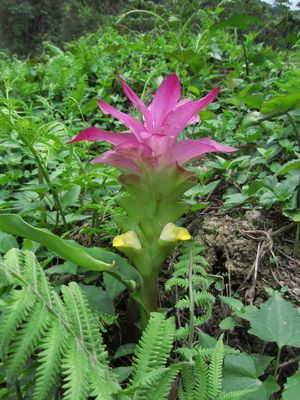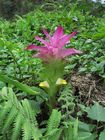Note: This is a project under development. The articles on this wiki are just being initiated and broadly incomplete. You can Help creating new pages.
Difference between revisions of "Curcuma aromatica - Wild turmeric, Aranyaharidra"
(→Chemical Composition) |
|||
| Line 13: | Line 13: | ||
==Chemical Composition== | ==Chemical Composition== | ||
| − | + | Rhizome yields essential oil, containing curdione and curcumol, colouring matter, cucurmin, resin, mucilage, albumionoids, starch, gum and sugar<ref name="chemical composition"/> | |
==Common names== | ==Common names== | ||
Revision as of 09:36, 7 April 2018
Curcuma aromatica is a member of the Curcuma genus belonging to the family Zingiberaceae. Botanically close to Curcuma australasica, wild turmeric has been widely used as a cosmetic herbal in South Asia and nearby regions.
Contents
Uses
Blisters in mouths, mouth sores, bleeding piles, leucorrhoea, Mild diabetes, Cough, physical weakness, ulcer, Urinary trouble, snakebite, infection in intestine.
Parts Used
Chemical Composition
Rhizome yields essential oil, containing curdione and curcumol, colouring matter, cucurmin, resin, mucilage, albumionoids, starch, gum and sugar[1]
Common names
| Language | Common name |
|---|---|
| Kannada | kasthuri arishina |
| Hindi | jangli haldi |
| Malayalam | kasthoori manjal, dantmanjal |
| Tamil | kasturimanjal |
| Telugu | kasthuri pasupa |
| Marathi | NA |
| Gujarathi | NA |
| Punjabi | NA |
| Kashmiri | NA |
| Sanskrit | |
| English | wild turmeric, aromatic turmeric |
Habit
Identification
Leaf
| Kind | Shape | Feature |
|---|---|---|
| Paripinnate | Oblong | Leaf Arrangementis Alternate-spiral |
.[2]
Flower
| Type | Size | Color and composition | Stamen | More information |
|---|---|---|---|---|
| Unisexual | 2-4cm long | pink | Flowering throughout the year and In terminal and/or axillary pseudoracemes |
Fruit
| Type | Size | Mass | Appearance | Seeds | More information |
|---|---|---|---|---|---|
| oblong pod | Thinly septate, pilose, wrinkled | seeds upto 5 | Fruiting throughout the year | {{{6}}} |
Other features
List of Ayurvedic medicine in which the herb is used
- Vishatinduka Taila as root juice extract
Where to get the saplings
Mode of Propagation
How to plant/cultivate
The perennials prefer a half-shady situation on moist soil. The substrate should be sandy-loamy or gritty-loamy soil. They tolerate temperatures only above at least 1°C[3]
Commonly seen growing in areas
Photo Gallery
- Pages that are stubs
- Ayurvedic Herbs known to be helpful to treat Blisters in mouths
- Ayurvedic Herbs known to be helpful to treat mouth sores
- Ayurvedic Herbs known to be helpful to treat bleeding piles
- Ayurvedic Herbs known to be helpful to treat leucorrhoea
- Ayurvedic Herbs known to be helpful to treat Mild diabetes
- Ayurvedic Herbs known to be helpful to treat Cough
- Ayurvedic Herbs known to be helpful to treat physical weakness
- Ayurvedic Herbs known to be helpful to treat ulcer
- Ayurvedic Herbs known to be helpful to treat Urinary trouble
- Ayurvedic Herbs known to be helpful to treat snakebite
- Ayurvedic Herbs known to be helpful to treat infection in intestine
- Herbs with Rhizome used in medicine
- Herbs with Oil used in medicine
- Herbs with common name in Kannada
- Herbs with common name in Hindi
- Herbs with common name in Malayalam
- Herbs with common name in Tamil
- Herbs with common name in Telugu
- Herbs with common name in English
- Habit - A small wiry straggler(5m)
- Index of Plants which can be propagated by Seeds
- Herbs that are commonly seen in the region of Trophical
- Herbs that are commonly seen in the region of Sub trophical
- Pages with reference errors

